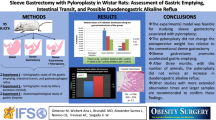Abstract
Gastric bypass is an extensive exclusion operation which was developed in 1966 and has been used in over 600 patients for the treatment of morbid obesity. Stomal ulceration has developed in 2% of patients and has usually occurred because the stomach was transected at too low a level. To determine the effect of varying levels of transection and exclusion of the stomach, graded gastric bypass was studied in 2 peptic ulcer models in dogs. With histamine-in-beeswax, stomal ulcers occurred whenever there was more than 63% of the stomach located above the gastroenterostomy. With common duct ligation, stomal ulcers were not observed in dogs with 44% or less of the stomach excluded, but when more than 44% of the stomach emptied through the duodenum, duodenal ulcers developed. Stomal ulceration occurred as a result of excessive acid production from large fundic segments stimulated by histamine. Duodenal ulcers resulted from a deficiency in buffering of acid when sufficient stomach was excluded and when an adequate volume of acid entered the duodenum where bile was excluded. These experiments add further emphasis to the importance of high transection of the stomach in gastric bypass, but also suggest that the occurrence of common duct obstruction will introduce the risk of duodenal ulcer in patients who have had gastric bypass for the treatment of obesity.
Résumé
Le bypass gastrique est une opération d'exclusion importante qui, depuis 1966, a été pratiquée chez plus de 600 malades atteints d'obésité pathologique. Un ulcère peptique est apparu dans 2% des cas, en général lorsque l'estomac avait été sectionné trop distalement. Pour préciser les effets du niveau de transsection gastrique et d'exclusion de l'estomac, nous avons étudié, chez le chien et sur 2 modèles d'ulcère peptique expérimental, les effets d'exclusions gastriques d'importance variable. Dans le modèle à l'histamine incluse en cire d'abeille, des ulcères peptiques se développent lorsque l'on laisse, au-dessus de la gastroentérostomie, plus de 63% de l'estomac. Dans l'autre modèle, à ligature du cholédoque, il n'y a pas d'ulcère peptique lorsque l'exclusion gastrique est inférieure ou égale à 44%; mais lorsqu'elle dépasse ces 44% et que l'estomac se draine dans le duodénum, des ulcères duodénaux apparaissent. Ces ulcères duodénaux sont dus à une insuffisance de neutralisation de la sécrétion acide, lorsque le segment d'estomac exclu est suffisamment grand et que des quantités importantes d'acide s'écoulent dans un duodénum privé de bile. Ces résultats expérimentaux soulignent l'importance d'une section haute de l'estomac dans le bypass gastrique; ils suggèrent, de plus, qu'une obstruction de la voie biliare principale entraîne un risque d'ulcère duodénal chez le patient opéré de bypass gastrique pour obésité.
Similar content being viewed by others
References
Mason, E.E., Ito, C.: Gastric bypass in obesity. Surg. Clin. North Am.47:1345, 1967
Mason, E.E., Printen, K.J., Hartford, C.E., Boyd, W.C.: Optimizing results of gastric bypass. Ann. Surg.182:405, 1975
Hornberger, H.R.: Gastric bypass. Am. J. Surg.131:415, 1976
Hermreck, A.S., Jewell, W.R., Hardin, C.A.: Gastric bypass for morbid obesity: results and complications. Surgery80:498, 1976
Alden, J.F.: A comparison of jejunoileal bypass and gastric bypass in the treatment of morbid obesity. Arch. Surg.112:199, 1977
Griffen, W.O., Jr., Young, V.L., Stevenson, C.C.: A prospective comparison of gastric and jejunoileal bypass procedures for morbid obesity. Ann. Surg.186:500, 1977
Sorrell, V.F., Burcher, S.K.: Gastric bypass for morbid obesity. N.Z. Med. J.84:96, 1976
Finsterer, H.: Ausgedehnte Magenresektion bei Ulcus duodeni statt der einfachen Duodenalresektion bzw. Pylorusausschaltung. Zentralbl. S. Chir.45:434, 1918
Devine, H.B.: Gastric exclusion. Surg. Gynecol. Obstet.47:239, 1928
Edkins, J.S.: On the chemical mechanism of gastric secretion. Proc. R. Soc. Lond.76:376, 1905
Gregory, R.A., Tracy, H.J.: The constitution and properties of two gastrins extracted from hog antral mucosa. Gut5:103, 1964
Mason, E.E., Munns, J.R., Kealey, G.P., Wangler, R., Clarke, W.R., Cheng, H.F., Printen, K.J.: Effect of gastric bypass on gastric secretion. Am. J. Surg.131:162, 1976
Code, C.F., Varco, R.L.: Chronic histamine action. Proc. Soc. Exp. Biol. Med.44:415, 1940
Hay, L.J., Varco, R.L., Code, CF., Wangensteen, O.H.: The experimental production of gastric and duodenal ulcers in laboratory animals by the intramuscular injection of histamine in beeswax. Surg. Gynecol. Obstet.75:170, 1942
Bickel, A.: Beobachtungen an Hunden mit exstirpiertem Duodenum. Berl. Klin. Wochenschr.46:1201, 1909
Bollman, J.L., Mann, F.C.: Peptic ulcer in experimental obstructive jaundice. Arch. Surg.24:126, 1932
Thompson, L.L. Jr., Frazier, W.D., Ravdin, I.S.: The renal lesion in obstructive jaundice. Am. J. Med. Sci.199:305, 1940
Freeman, J.B., Meyer, P.D., Printen, K.J., Mason, E.E., DenBesten, L.: Analysis of gallbladder bile in morbid obesity. Am. J. Surg.129:163, 1975
Mabee, T.M., Meyer, R., DenBesten, L., Mason, E.E.: The mechanism of increased gallstone formation in obese human subjects. Surgery79:460, 1976
Anrep, G.V., Barsoum, G.S.: Blood histamine in experimental obstruction of the common bile duct. J. Physiol.120:427, 1953
Goksen, Y., Hardy, J.D.: Histamine in the gastric hypersecretion following biliary obstruction in dogs. Arch. Surg.96:104, 1968
DeBakey, M.E.: Peptic ulceration. The relative protective value of alkaline duodenal juices. Arch. Surg.34:230, 1937
Kuroyanagi, Y., Chiles, T., Necheles, H.: Effect of bile salt on pancreatic secretion of the dog. Am. J. Physiol.203:241, 1962
Breen, J.J., Molina, E., Ritchie, W.P., Jr.: Effect of common bile-duct transplantation on gastric acid secretion in the dog. Br. J. Surg.55:282, 1968
Code, C.F.: New antagonists excite an old histamine prospector (Editorial). N. Engl. J. Med.290:738, 1974
Kay, A.W.: The pyloric antrum and peptic ulceration. Gastroenterologia89:282, 1958
Waddell, W.R., Bartlett, M.K.: Antral exclusion with vagotomy for duodenal ulcer. I. Acid-secretory studies on 50 patients. Ann. Surg.146:3, 1957
Author information
Authors and Affiliations
Rights and permissions
About this article
Cite this article
Mason, E.E., Ito, C. Graded gastric bypass. World J. Surg. 2, 341–347 (1978). https://doi.org/10.1007/BF01561513
Issue Date:
DOI: https://doi.org/10.1007/BF01561513




